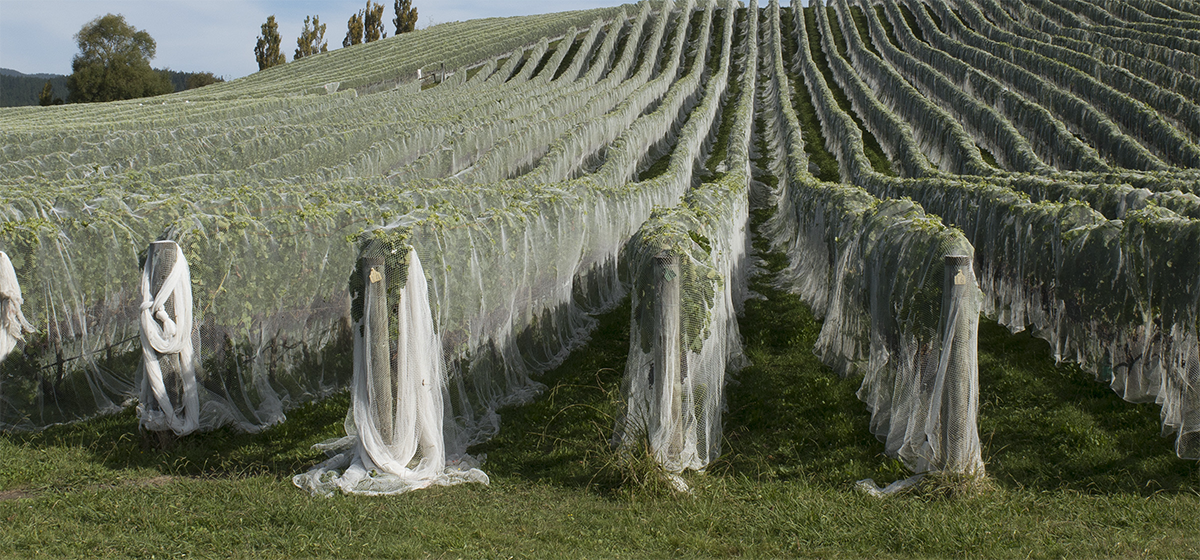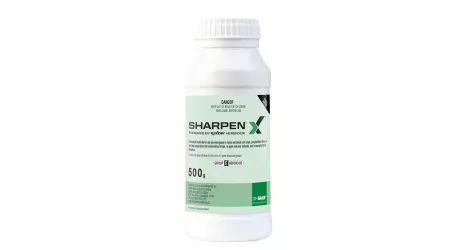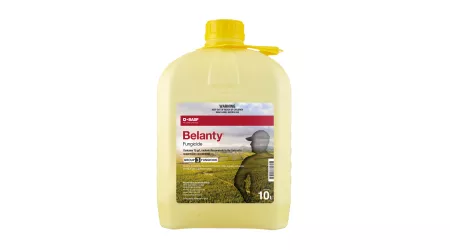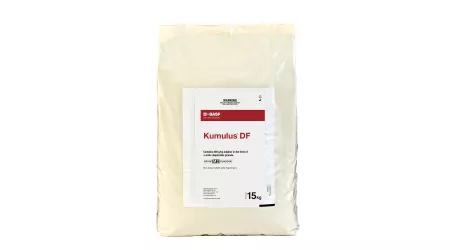Key benefits
- Rapid and robust knockdown control of over 60 weed species
- A higher level of crop safety than glyphosate, especially for young trees and vines
- Fast-acting (visible impact within 3 days, knockdown in 7–10 days)
- Superior performance on some weeds resistant to glyphosate
How it works
The active ingredient in Buster® is glufosinate-ammonium, a Group H herbicide which works by inhibiting the enzyme glutamine synthetase. Lack of glutamine synthetase leads to plant death through multiple disruptions of the plant metabolism, including the breakdown of photosynthesis.
Despite the absence of visual symptoms, the treated plants stop growing within the first day after application of Buster. Complete death of the weeds usually occurs between one and two weeks after treatment.
Crop suitability
-
Brambles
Primocane control -
Citrus
Annual poaAsparagus seedlingsBeaked hawksbeardBlack nightshadeBrackenBristle grassBroomBur medickButtercupsCalandriniaCat's earChewing's FescueChickweedCleaversClover seedlingsCloversCornbindCouchCrowfoot grassCut-leaved geraniumDaisyDandelionDocksField pansyFleabaneGorseHairy buttercupsHawksbeardIndian doabKikuyu grassMallowsMeadow rice grassMouse-ear chickweedMusky storksbillParsley PiertPaspalumPrairie grassRapeRedrootRough-stalked meadow grassRushesRyegrassScotch thistleSedgesSheep's sorrelSow thistleSpurreyStaggerweedStinking mayweedStorksbillStrawberrySubterranean cloverSummer grassTall FescueTwin cressWild strawberryWild turnipWillow herbWillow weedWireweedYarrowYorkshire Fog -
Grapes
Annual poaAsparagus seedlingsBeaked hawksbeardBlack nightshadeBrackenBristle grassBroomBur medickButtercupsCalandriniaCat's earChewing's FescueChickweedCleaversClover seedlingsCloversCornbindCouchCrowfoot grassCut-leaved geraniumDaisyDandelionDocksField pansyFleabaneGorseHairy buttercupsHawksbeardIndian doabKikuyu grassMallowsMeadow rice grassMouse-ear chickweedMusky storksbillParsley PiertPaspalumPrairie grassRapeRedrootRough-stalked meadow grassRushesRyegrassScotch thistleSedgesSheep's sorrelSow thistleSpurreyStaggerweedStinking mayweedStorksbillStrawberrySubterranean cloverSummer grassTall FescueTwin cressWild strawberryWild turnipWillow herbWillow weedWireweedYarrowYorkshire Fog -
Kiwifruit
Annual poaAsparagus seedlingsBeaked hawksbeardBlack nightshadeBrackenBristle grassBroomBur medickButtercupsCalandriniaCat's earChewing's FescueChickweedCleaversClover seedlingsCloversCornbindCouchCrowfoot grassCut-leaved geraniumDaisyDandelionDocksField pansyFleabaneGorseHairy buttercupsHawksbeardIndian doabKikuyu grassMallowsMeadow rice grassMouse-ear chickweedMusky storksbillParsley PiertPaspalumPrairie grassRapeRedrootRough-stalked meadow grassRushesRyegrassScotch thistleSedgesSheep's sorrelSow thistleSpurreyStaggerweedStinking mayweedStorksbillStrawberrySubterranean cloverSummer grassTall FescueTwin cressWild strawberryWild turnipWillow herbWillow weedWireweedYarrowYorkshire Fog -
Non-crop areas
Annual poaAsparagus seedlingsBeaked hawksbeardBlack nightshadeBrackenBristle grassBroomBur medickButtercupsCalandriniaCat's earChewing's FescueChickweedCleaversClover seedlingsCloversCornbindCouchCrowfoot grassCut-leaved geraniumDaisyDandelionDocksField pansyFleabaneGorseHairy buttercupsHawksbeardIndian doabKikuyu grassMallowsMeadow rice grassMouse-ear chickweedMusky storksbillParsley PiertPaspalumPrairie grassRapeRedrootRough-stalked meadow grassRushesRyegrassScotch thistleSedgesSheep's sorrelSow thistleSpurreyStaggerweedStinking mayweedStorksbillStrawberrySubterranean cloverSummer grassTall FescueTwin cressWild strawberryWild turnipWillow herbWillow weedWireweedYarrowYorkshire Fog -
Pome fruit
Annual poaAsparagus seedlingsBeaked hawksbeardBlack nightshadeBrackenBristle grassBroomBur medickButtercupsCalandriniaCat's earChewing's FescueChickweedCleaversClover seedlingsCloversCornbindCouchCrowfoot grassCut-leaved geraniumDaisyDandelionDocksField pansyFleabaneGorseHairy buttercupsHawksbeardIndian doabKikuyu grassMallowsMeadow rice grassMouse-ear chickweedMusky storksbillParsley PiertPaspalumPrairie grassRapeRedrootRough-stalked meadow grassRushesRyegrassScotch thistleSedgesSheep's sorrelSow thistleSpurreyStaggerweedStinking mayweedStorksbillStrawberrySubterranean cloverSummer grassTall FescueTwin cressWild strawberryWild turnipWillow herbWillow weedWireweedYarrowYorkshire Fog -
Raspberries
Primocane control -
Stale seedbed preparation
Annual poaAsparagus seedlingsBeaked hawksbeardBlack nightshadeBrackenBristle grassBroomBur medickButtercupsCalandriniaCat's earChewing's FescueChickweedCleaversClover seedlingsCloversCornbindCouchCrowfoot grassCut-leaved geraniumDaisyDandelionDocksField pansyFleabaneGorseHairy buttercupsHawksbeardIndian doabKikuyu grassMallowsMeadow rice grassMouse-ear chickweedMusky storksbillParsley PiertPaspalumPrairie grassRapeRedrootRough-stalked meadow grassRushesRyegrassScotch thistleSedgesSheep's sorrelSow thistleSpurreyStaggerweedStinking mayweedStorksbillStrawberrySubterranean cloverSummer grassTall FescueTwin cressWild strawberryWild turnipWillow herbWillow weedWireweedYarrowYorkshire Fog -
Stone fruit
Annual poaAsparagus seedlingsBeaked hawksbeardBlack nightshadeBrackenBristle grassBroomBur medickButtercupsCalandriniaCat's earChewing's FescueChickweedCleaversClover seedlingsCloversCornbindCouchCrowfoot grassCut-leaved geraniumDaisyDandelionDocksField pansyFleabaneGorseHairy buttercupsHawksbeardIndian doabKikuyu grassMallowsMeadow rice grassMouse-ear chickweedMusky storksbillParsley PiertPaspalumPrairie grassRapeRedrootRough-stalked meadow grassRushesRyegrassScotch thistleSedgesSheep's sorrelSow thistleSpurreyStaggerweedStinking mayweedStorksbillStrawberrySubterranean cloverSummer grassTall FescueTwin cressWild strawberryWild turnipWillow herbWillow weedWireweedYarrowYorkshire Fog
Questions and Answers from the Field
-
Is glufosinate the same as glyphosate?
Glufosinate and glyphosate are both non-selective herbicides used for weed control, but they differ in their mode of action. Glyphosate is a systemic herbicide that moves within the plant to kill it, while glufosinate, the active ingredient in BASF’s Buster, is partially systemic, providing a higher level of crop safety than glyphosate.
-
What is the active ingredient in Buster herbicide?
The active ingredient in BASF’s Buster herbicide is glufosinate-ammonium. Buster is different from glyphosate.
-
What are the best herbicides to control weeds for fruit trees?
One of the best herbicides to control weeds in orchards is BASF’s Buster herbicide. Buster is an effective choice for controlling weeds in orchards and vineyards. Buster is particularly effective against hard-to-kill weeds like clover, willow herb, mallows, and storksbill.
-
How do you get rid of weeds glyphosate struggles to control?
BASF’s Buster herbicide can be used to get rid of common weeds, including mallow and storksbill that glyphosate doesn’t control well. Buster herbicide has a unique formulation that makes it particularly effective on hard-to-kill weeds.
-
What is the strongest herbicide?
BASF’s Buster herbicide is a strong and effective herbicide that can control a wide range of weeds. Buster provides a higher level of crop safety than systemic alternatives like glyphosate and offers robust control against a broad spectrum of weed species.
-
What is the importance of stale seedbed?
The stale seedbed technique involves preparing the soil and allowing weed seeds to germinate, then killing them before planting the crop. This technique is important because it helps to reduce the weed population before planting, making it easier to manage weeds during the crop's growth. BASF’s Buster herbicide is registered for the preparation of stale seedbeds, particularly where clover is a problem weed.




